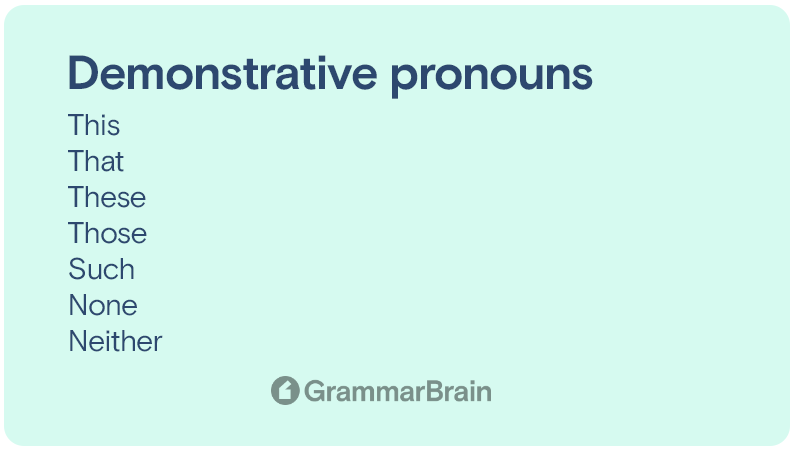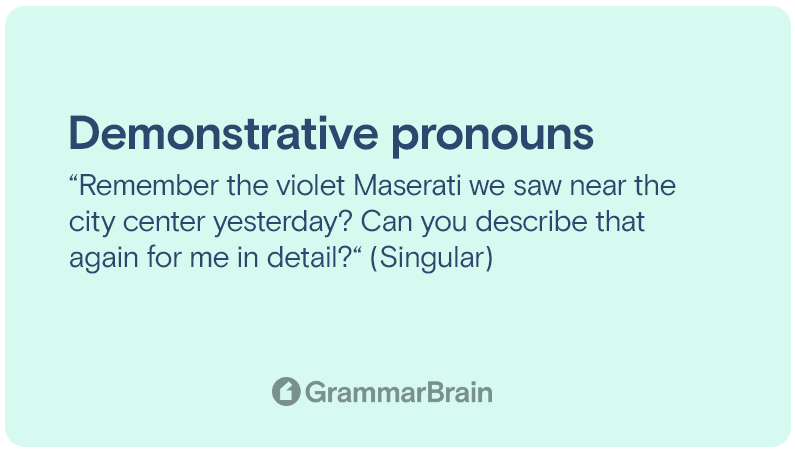A demonstrative pronoun is a type of pronoun that is specifically used to point toward any person or object. It is implied that it can also point toward multiple or a group of persons as well as objects.
What is a demonstrative pronoun? A simple definition
A simple definition would be: it is a kind of pronoun that represents and replaces a noun along with the indication of its relative position. Take, for instance, a Ferrari car that is parked very near to where you are standing right now. You say “This is a Ferrari.”

On the other hand, you would address a Lamborghini that is parked across the street as: “That is a Lamborghini”. In the above two examples the pronouns ‘this’ and ‘that’ are the demonstrative pronouns.
The list of demonstrative pronouns is as follows:
1) This (Singular)
2) That (Singular)
3) These (Plural)
4) & Those (Plural)
5) Such (Singular and plural)
6) None (Singular and plural)
7) Neither (Only Singular)
‘These’ and ‘those’ are used in the same way as ‘this’ and ‘those’ but in the plural sense. And the first four pronouns in the list are the most widely used. The last three, ‘such’, ‘none’, and ‘neither’ are the less widely used demonstrative pronouns.
Examples of demonstrative pronouns in sentences
Just like other pronouns, demonstrative pronouns too are used in place of nouns or phrases. They replace these nouns or phrases and can be used independently.
Examples:
- “Remember the violet Maserati we saw near the city center yesterday? Can you describe that again for me in detail? “ (Singular)
- “I am going to get myself new denim pants. These are getting pretty worn out.” (Plural)
- “I don’t have the slightest guess what this could mean.” (Singular)
- “I guess this stereo will be the least expensive among those on display.” (Plural)
- “You remember the lads that turned up at the interview yesterday? None of them were selected.” (Plural)
- “If such is the condition of the dormitory, the boys are definitely going to rebel.” (Singular)
- “Such are the achievements of the army’s mountaineering team.” (Plural)
- “Neither of the couple listens to the other.” (Singular)
What is a demonstrative example?
The word ‘demonstrative’ is an umbrella term that commonly refers to words that denote a person, persons, an object, or objects. It includes demonstrative adjectives, also known as demonstrative determiners, and demonstrative pronouns.

How do you use demonstrative in a sentence?
The usage of demonstratives can be best illustrated with the following examples:
- “Can you pick that book over there for me?” (Demonstrative Adjective)
- “That book over there, can you pick that for me?” (Demonstrative Pronoun)
- “These oranges look ripe and enticing.” (Demonstrative Adjective)
- “Of all the oranges in the garden, these look ripe and enticing.” (Demonstrative Pronoun)
Demonstrative pronoun vs. demonstrative adjective
The four primary demonstrative pronouns ‘this’, ‘that’, ‘these’, and ‘that’ can also be used as demonstrative adjectives. This can be a bit confusing, but with proper clarity, the doubts can be dispelled.
An adjective is a word that defines a noun or its quality. A pronoun on the other hand replaces a noun.
Likewise, a demonstrative adjective is an adjective that also points to a noun indicating its relative nearness. Here, the demonstrative adjective has to be used along with the noun.
Example: “These horses represent the finest breed from Arabia.”
‘These’ is used along with and to indicate the noun ‘horses’, and hence acts as an adjective.
Now consider this example:
- “Of the entire race horses summoned here, these are the finest breed from Arabia.”
In this above example, ‘these’ replaces the noun ‘horses’, and hence acts as a pronoun. Thus, a demonstrative pronoun is a pronoun that also points toward a noun (or nouns) indicating its relative nearness.
Therefore, we have seen that the four primary demonstrative pronouns also act as demonstrative adjectives.
FAQs
How many demonstrative pronouns are there?
As discussed earlier, there are four primary demonstrative pronouns. They are this, that, these, and those.
Out of these, this and that are singular demonstrative pronouns, and these and those are pluralistic demonstrative pronouns. There are three more demonstrative pronouns that are less widely used. They are such, none, and neither.
Out of these, such and none are used in both singular and pluralistic forms. Neither is used as singular alone.
Are demonstrative pronouns the same as demonstrative determiners?
No. Demonstrative pronouns are not the same as demonstrative determiners.
Demonstrative determiners are adjectives, and they are used along with nouns to define them.
Demonstrative pronouns, on the other hand, are pronouns that are used instead of the nouns that they replace.
Are demonstrative pronouns and demonstrative adjectives the same?
It’s easy to confuse demonstrative pronouns with demonstrative adjectives. They’re similar, but a demonstrative pronoun stands alone, while a demonstrative adjective qualifies a noun.
Sources
- What Is A Demonstrative Pronoun? Definition And Examples
- 5. Demonstrative Pronouns – English grammar
- Demonstrative – Wikipedia
- What Is a Demonstrative Pronoun? Examples & Exercises
Inside this article
Fact checked:
Content is rigorously reviewed by a team of qualified and experienced fact checkers. Fact checkers review articles for factual accuracy, relevance, and timeliness. Learn more.
Core lessons
Glossary
- Abstract Noun
- Accusative Case
- Anecdote
- Antonym
- Active Sentence
- Adverb
- Adjective
- Allegory
- Alliteration
- Adjective Clause
- Adjective Phrase
- Ampersand
- Anastrophe
- Adverbial Clause
- Appositive Phrase
- Clause
- Compound Adjective
- Complex Sentence
- Compound Words
- Compound Predicate
- Common Noun
- Comparative Adjective
- Comparative and Superlative
- Compound Noun
- Compound Subject
- Compound Sentence
- Copular Verb
- Collective Noun
- Colloquialism
- Conciseness
- Consonance
- Conditional
- Concrete Noun
- Conjunction
- Conjugation
- Conditional Sentence
- Comma Splice
- Correlative Conjunction
- Coordinating Conjunction
- Coordinate Adjective
- Cumulative Adjective
- Dative Case
- Determiner
- Declarative Sentence
- Declarative Statement
- Direct Object Pronoun
- Direct Object
- Diction
- Diphthong
- Dangling Modifier
- Demonstrative Pronoun
- Demonstrative Adjective
- Direct Characterization
- Definite Article
- Doublespeak
- False Dilemma Fallacy
- Future Perfect Progressive
- Future Simple
- Future Perfect Continuous
- Future Perfect
- First Conditional
- Irregular Adjective
- Irregular Verb
- Imperative Sentence
- Indefinite Article
- Intransitive Verb
- Introductory Phrase
- Indefinite Pronoun
- Indirect Characterization
- Interrogative Sentence
- Intensive Pronoun
- Inanimate Object
- Indefinite Tense
- Infinitive Phrase
- Interjection
- Intensifier
- Infinitive
- Indicative Mood
- Participle
- Parallelism
- Prepositional Phrase
- Past Simple Tense
- Past Continuous Tense
- Past Perfect Tense
- Past Progressive Tense
- Present Simple Tense
- Present Perfect Tense
- Personal Pronoun
- Personification
- Persuasive Writing
- Parallel Structure
- Phrasal Verb
- Predicate Adjective
- Predicate Nominative
- Phonetic Language
- Plural Noun
- Punctuation
- Punctuation Marks
- Preposition
- Preposition of Place
- Parts of Speech
- Possessive Adjective
- Possessive Determiner
- Possessive Case
- Possessive Noun
- Proper Adjective
- Proper Noun
- Present Participle
- Prefix
- Predicate



